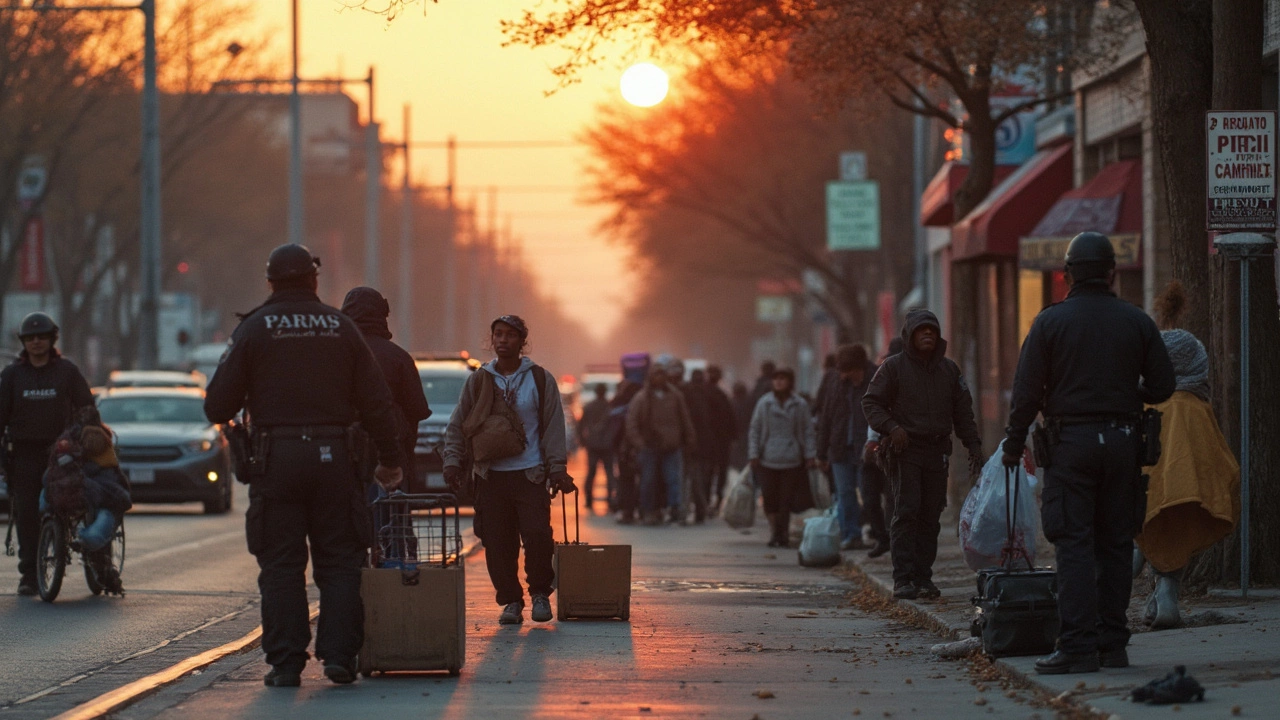Texas has brought in new laws affecting homeless people and the way shelters operate. This article breaks down the most recent rules, explains what people living on the streets need to know, and sheds light on how shelters are responding. Readers will learn about bans on public camping, ID policies, and fines, plus how shelters are adjusting services to match legal changes. Practical tips help anyone looking to understand, navigate, or help with the new legal landscape.

- Created by: Lydia Carmichael
- Completed on: 4 Apr 2025
- Categories: Homeless Support
Did you know that one of the most sought-after items by those experiencing homelessness isn’t food but clean socks? Yep, it might surprise us, but things we often take for granted can be crucial for someone else. Socks wear out fast, especially for those walking long distances daily. Having a fresh pair can mean the difference between comfort and blistered feet.
Another biggie on the list is personal hygiene products. Imagine trying to stay clean without soap, shampoos, toothpaste, or sanitary products—it's definitely tough. These items aren’t just about cleanliness; they’re about dignity and health, too. They help keep people feeling human and stave off illnesses.
It’s pretty eye-opening, right? But there's even more to understand about what homeless shelters need and how we can best help. Stick around to learn how you can make a real difference by donating the right stuff.
- The Essentials People Ask For
- Why Personal Hygiene Products Top the List
- The Comfort of Clean Socks and Underwear
- Unexpected but Important: Non-Perishable Food
- Ways to Get Involved and Help
- Making Donations Effective and Meaningful
The Essentials People Ask For
When we think of donations to homeless shelters, canned food and clothes come to mind. But there's more to it. The people living on the streets have very specific needs that might surprise those of us who live with the comfort of a home.
Let’s break this down. First off, beyond socks, one of the top things folks request is underwear. Think about it: clean undergarments are essential for hygiene and comfort. Even though they are rarely donated, they are in high demand.
Then comes hygiene products. People need items like toothbrushes, toothpaste, deodorant, and menstrual products. Often turning to shelters for these basics, they're vital for maintaining dignity and health.
Here’s something else: non-perishable food items are less requested but still appreciated. Specific types like protein bars and canned tuna or chicken provide vital nutrients that might otherwise be hard to come by.
You might be wondering if there's anything else you're missing. Well, cleaning supplies occasionally make the list too. Stuff like disinfectant wipes or small bottles of hand sanitizer can be a game-changer.
So, when you’re considering a donation, think beyond the obvious. These items might not be glamorous, but in the world of homelessness, they’re treasures.
Why Personal Hygiene Products Top the List
When you think about what's essential, personal hygiene products probably aren't the first thing that pops into your mind, but for those at homeless shelters, they're like gold. Let's break it down—these items play a huge role in maintaining dignity and health. We're talking about soap, toothpaste, toothbrushes, shampoo, deodorant, and even sanitary products.
Now, why do these matter so much? Picture trying to get through even a week without access to these basics. It's nearly impossible to feel good about yourself when you can't get clean. For many, staying clean is the first step to feeling 'normal' again, which is crucial for physical and mental well-being.
In shelters, supplies can run low quickly because there's a constant demand. Studies show that having access to these products significantly reduces the spread of illnesses. Plus, it helps folks gain confidence to apply for jobs or housing, as hygiene is often underestimated as a silent deal-breaker.
Another key point is the cost. Most personal hygiene products are not covered by food stamps, leaving many with no choice but to go without. By donating these items, you directly help those who don't have the means to buy what they need to stay healthy and presentable.
If you're thinking about helping out, consider creating a small kit. Here's a simple list you could use:
- Travel-size shampoo and conditioner
- Soap or body wash
- Toothpaste and toothbrush
- Deodorant
- Feminine hygiene products
- Small pack of wipes
Without a doubt, your contributions make a world of difference by providing comfort and restoring a sense of self-worth to those in need.
The Comfort of Clean Socks and Underwear
Let’s talk about something we might not often think about—clean socks and underwear. They’re not just about comfort; they're crucial for health, especially for folks without access to washing machines.
For people experiencing homelessness, staying clean is a daily challenge. Imagine not having a fresh pair of socks when yours are wet from the rain or sweaty from walking. Wet feet can lead to blisters, infections, and serious foot problems. This is why clean socks are one of the most frequently requested items in homeless shelters across the country.
Underwear also makes a big difference. It’s a basic need that helps maintain personal hygiene and self-esteem. For many folks, having even a small collection of these essentials can help preserve a sense of dignity and comfort.
When thinking about what to donate, focus on new items. Everyone deserves new, fresh clothing next to their skin. Consider neutral styles and colors that most people can use. Here’s a quick tip: buy packs when they’re on sale, and you can donate some while keeping the rest for your household.
In a survey of homeless shelters, 90% said their biggest wish is more donations of socks and underwear. These basic items seem small, but they have an outsized impact. When you're planning to donate, remember how something so simple to us might be invaluable to someone else.

Unexpected but Important: Non-Perishable Food
When you think of donations to homeless shelters, socks and hygiene items might come to mind first, but non-perishable food is another real lifesaver. These items can be stored easily, distributed without hassle, and provide much-needed nourishment. Think about how tough it is not knowing when your next meal is coming. Non-perishable foods offer a reliable solution to this uncertainty.
Canned goods, like soups, fruits, and beans, are awesome because they're usually ready-to-eat. Peanut butter and other spreads also rank high on the list because they pack a lot of energy and proteins, crucial for someone who might be out and about all day. Whole grain crackers and granola bars are another favorite because they’re easy to carry and don’t spoil quickly.
"Providing non-perishable food isn’t just about feeding people—it’s about offering them a stable source of nutrition," says Mary Thompson, Director at a local shelter. "A can of soup can be a lifesaver on a cold night."
But not just any food will do. It's important to consider the nutritional value and ease of use. Here are some of the top recommended non-perishable items:
- Canned vegetables and fruits: They offer essential vitamins and are often eaten straight from the can.
- Nut butter: High in protein and durable over time.
- Instant oatmeal: It's compact and easy to prepare with just boiling water.
- Rice and pasta: Filling staples that can feed many.
And hey, it’s not just about the food. Knowing which non-perishables are most needed helps us give in ways that are truly helpful, not just convenient for us. For those wanting to donate, local food banks and shelters often have lists of high-demand items. Reaching out to them can make your donations even more impactful.
| Non-Perishable Item | Benefits |
|---|---|
| Canned Soup | Readily available meal, provides warmth and comfort |
| Pasta | Filling and versatile, can be paired with various sauces |
| Granola Bars | Portable and energy-rich |
| Rice | Long shelf-life, filling, and nutritious |
We can all do our part by providing essential non-perishable foods, making a difference one can—one box—at a time. Not only does it fill bellies, but it also shows we care, and that’s pretty important too.
Ways to Get Involved and Help
If you're wondering how you can make a difference for those using homeless shelters, it’s easier than you might think. Your involvement can be as simple or as involved as you want it to be. Here are some practical ways you can help right now!
First things first, let's talk donations. Knowing what to give is key. Sure, cash donations are always appreciated because they give shelters the flexibility to buy exactly what’s needed. But physical donations, especially of those requested items like personal hygiene kits and clean socks, are super impactful. Make sure to reach out to your local shelter to see their current needs, as they can vary.
- Food Contributions: Non-perishable food items like canned goods, pasta, and rice are always in demand. Consider organizing a food drive with your school, workplace, or neighborhood.
- Personal Time: If you have some time to spare, consider volunteering. Many shelters need help during meal times or organizing donations. It's a great way to connect and see the impact first-hand.
- Organize Fundraisers: Got a knack for organizing events? Hosting a fundraiser can galvanize your community and raise funds for buying essential supplies for shelters.
- Advocate and Spread the Word: Use your voice! Educating friends and family about the realities of homelessness and the needs of shelters can increase awareness and bring in more support.
According to a study by the National Alliance to End Homelessness, effective community support plays a significant role in reducing the number of people without housing. Imagine how much progress we could make together if everyone chipped in a little!
Remember, no contribution is too small. Even if it’s just one pair of socks, it’s one pair someone didn’t have before. And that can mean the world to someone. So, why not check in with a local shelter today and see how you can help?
Making Donations Effective and Meaningful
When thinking about donating, the key is to deliver what will truly make a difference. Instead of just old clothes or random canned goods, think strategically about what might be most needed. Here’s the scoop on making your donations to homeless shelters really count.
First up, always check with the shelter directly. They often keep lists of their most requested items. Sometimes it's not just about the item but the quantity and timing, too. For instance, they might have an overflow of summer clothes but desperately need winter gear as the colder months roll in.
Another tip: consider packaging for hygiene products and food. Single-serving sizes or travel-sized toiletries are often ideal because they’re easy to carry and distribute. Plus, they're usually designed with space-saving in mind, which is crucial for people who don't have the luxury of space.
- Hygiene Kits: Grouping together small items like toothbrushes, toothpaste, shampoo, and soap helps a lot. It’s like creating a mini survival kit!
- Socks and Underwear: These are always on-demand and yet often overlooked. Opt for new items, as these are essential for comfort and hygiene.
- Non-Perishable Foods: Protein bars, canned soups, or peanut butter—non-perishables packed with nutrients are always welcome.
Don’t forget money. Cash donations give shelters the flexibility to buy exactly what they need when they need it. Sometimes a financial gift can stretch further than physical goods.
Lastly, involve others! Hosting a donation drive can multiply your impact. You can make it a community event, engaging schools, workplaces, or local groups.
With these steps, you’re not just giving away items. You’re providing thoughtful support that can ease someone’s daily struggle, offering them the dignity and relief they deserve.
Discover the most requested items by people experiencing homelessness and why they matter. From hygiene products to socks, these necessities make a significant impact. Learn how you can help and make thoughtful contributions that truly benefit those in need.
Finding yourself without a place to stay can be daunting, but knowing where to find help makes all the difference. From traditional shelters to unique options like micro-housing, we've gathered key insights to guide you. Discover practical tips and surprising facts about safe places that offer not just room and board, but also support and resources. Equip yourself with knowledge that could be lifesaving in challenging times.

